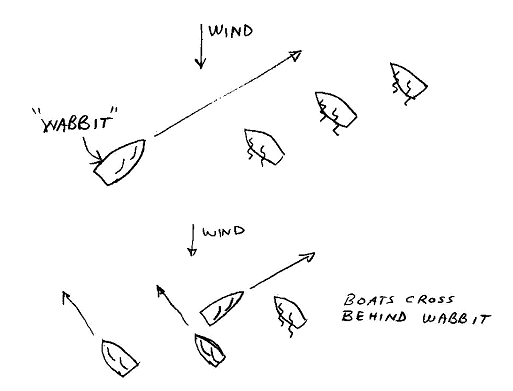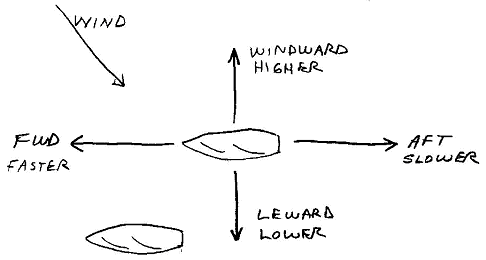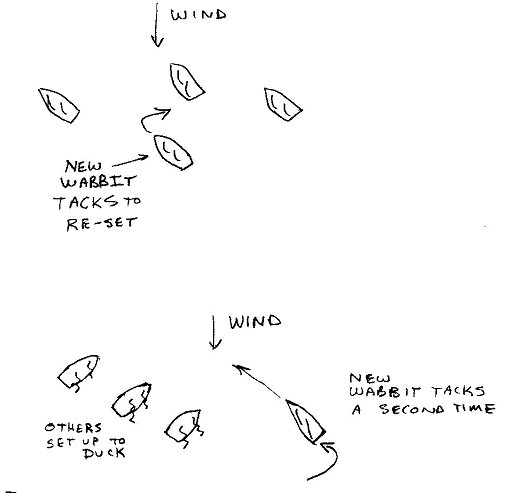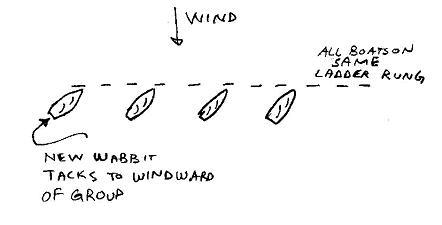By Barney Harris 6701
You and your crew and three other boats head out for an afternoon of mid week practice. Having had to bail out of work early and dis the family, you want to make the most of the time on the water. The wind is blowing nicely. All four boats sail into open water. After 15 minutes of gesticulating and shouting over the wind, you finally get the idea across to the other boats to sail upwind. Everyone sheets in – but one boat is not in clear air and falls rapidly behind. Another boat is pointing significantly higher than the others and becomes separated. You try to get everyone together, and after another 15 minute delay, the group is off again. Before long it becomes late in the afternoon and time to head home. The group went out with the best intentions but in reality only got about 25 cents on the dollar for the time spent.
Practice is one of three essential facets in a dinghy racing program. To get the best bang for the time invested, one must not leave the shore without a good game plan. Here are some thoughts on upwind pacing exercises:
- There is no way to shout instructions to multiple boats over the wind. It is therefore imperative that everyone knows what they will be doing before leaving the shore so no discussion on the water is required.
- Begin in an area of open water with a long fetch to windward and steady breeze.
- Its critical to keep the boats together. Ideally one will have all boats within a few boat lengths of one another so that an “apples to apples” comparisons can be made. If boats are separated by more than 4 or 5 boat lengths, they will be in differing wind and sea conditions, and will invalidate any results.
- All boats must sail in clear air and water. If a boat ends up in bad air, they will go slower no matter who is driving and no one learns anything.
- No more than four boats. More than 4 boats can only work if every boat’s skipper and crew are accomplished at this technique.
Here is the procedure:
Pick one boat to be the rabbit. Set up towards the leeward side of the sailing area. When all are ready, the rabbit sails as fast as possible on close hauled on port (or starboard) tack. The other boats set up on a close hauled course on starboard tack with their sails luffing. As the rabbit sails by, the other boats sheet in and accelerate to top speed, crossing close behind the rabbit in the process.

The rabbit sails for 1.5 to 2 boat lengths past the last boat and tacks. Ideally there will now be between 1.5 and 2 boat lengths between each boat, and all boats will be on close hauled, at top speed, and on the same “ladder rung.” There is enough space for each boat to sail in undisturbed air and water, yet they are close enough that all are sailing in pretty much the same conditions.

Each driver and crew must focus 100% on making the boat go as fast as possible. I will have the crew call out how each boat is doing relative to the others – I will concentrate on steering and sheeting the boat so intently that I will not want to look away for even a second. In order to communicate, the boat crew must be able to communicate the relative change in position. Generic statements such as “we’re doing better now;” and “they’re going faster” are meaningless and force the driver to look away from the sails to see what the crew is trying to convey. I prefer a simple coordinate system based on the longitudinal and transverse axes of the boat as depicted below.

Now when a crew says “boat ABC is climbing to windward on us” or “they are moving forward” it has some meaning. Even better is “boat xyz has climbed ½ boat length” or “we have moved to bow even with boat def to leeward.” This enables the crew to look around and talk while the driver drives.
Eventually one or more boats will begin to work ahead of the others, and one will fall behind. When any boat can not maintain their lane, they should tack. This is the indication to the other boats that its time to re set. The boat that tacked is now the rabbit for the others.

In this case the group had been pacing on starboard, so the rabbit must sail past all of the other boats and then tack a second time to starboard. The other boats must tack and position themselves in individual lanes and be ready to pass behind the rabbit on port. After the last boat crosses, the rabbit tacks onto port and the process repeats.

In this way the group sails more or less to windward, first on port, then on starboard, resetting as appropriate. All the boats tend to stay together. No one spends much time in disturbed air, since the boat that loses its lane is the one to initiate the reset. Most importantly, no on the water debate is required.
Keep and eye on the breeze to windward and the compass heading and adjust your feedback based on the wind shifts and variations in pressure. For example, in the spring sea breezes we sometimes get on the Chesapeake Bay, the wind shifts to the right the further one gets to the western shore. This windward boat appears to climb off those to leeward while tuning on starboard. Conversely the leeward boat appears to climb on a boat to windward while on port. In practice last season we would rapidly climb away from our tuning partner, who was generally lower and faster. We would rapidly become separated when we set up to windward. It was very interesting when we set up to leeward – with us gravitating towards pointing and our partner gravitating toward footing, each of us were forced to sail away from our normal modes, a very interesting exercise.
There is plenty of reason to practice with an International championship in North America this year. July is coming – are you ready?
